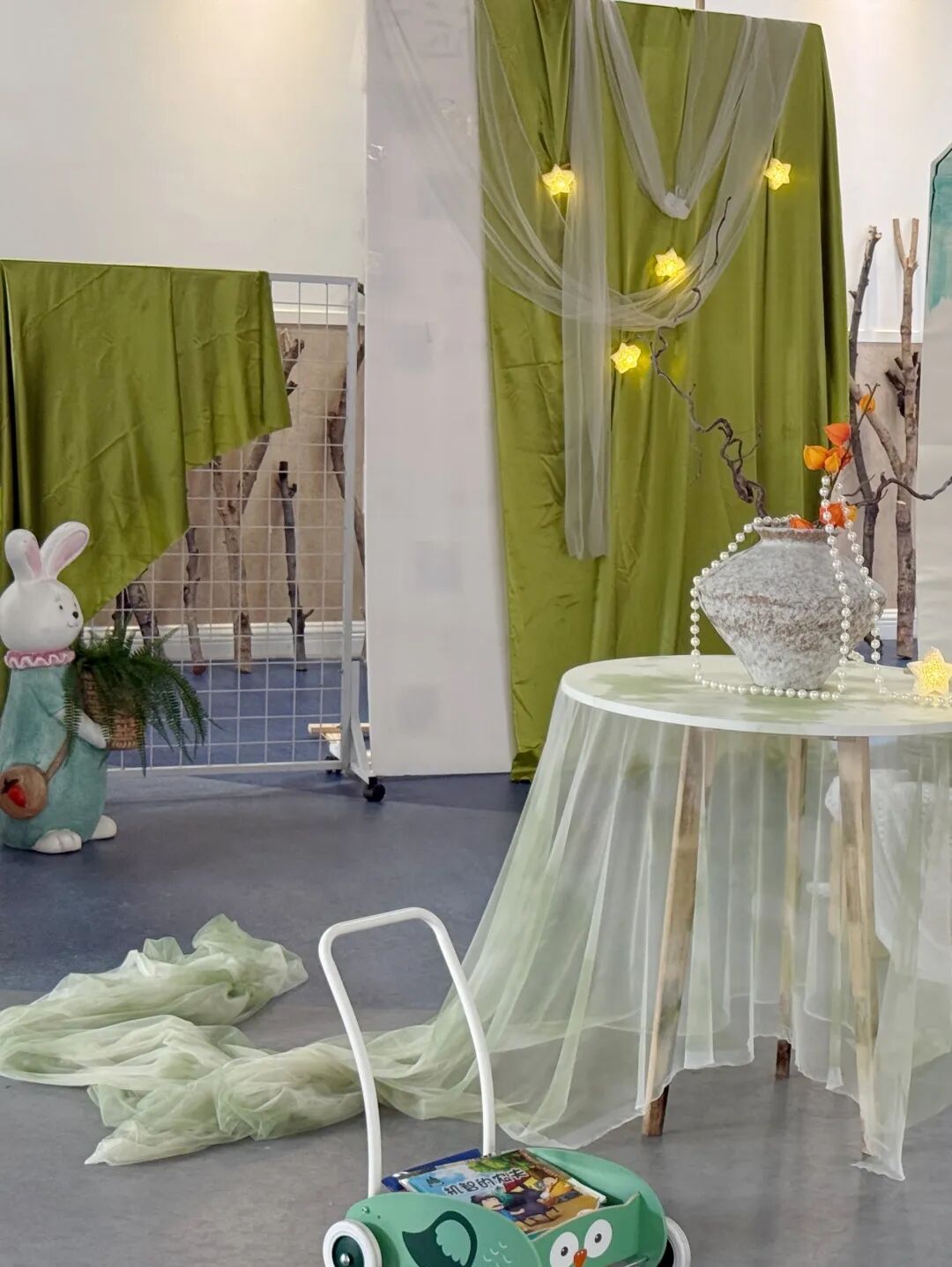教育,就是你的每一个奇思妙想,我都会仰头欣赏,你每前进一步,我都会为你鼓掌欢呼。
研究表明,师幼互动的特点直接影响儿童的认知与社会性能力的发展。《幼儿园3-6岁儿童学习与发展指南》中提到:师幼互动质量对于幼儿的学习和发展以及幼儿园整体教育质量具有重要意义,教育过程的质量是教育的核心目标,而师幼互动是教育过程中的核心目标。它是知识传递的桥梁,也是情感共鸣的滋养,通过真诚的对话、情感的表达和启发性的引导,来给师幼之间建立起一种特殊的互动关系。因此,为助力园所教师具备高质量师幼互动的能力,让教师与幼儿在各种活动中形成良好的师幼关系,促进幼儿发展,我园成立“师幼互动”学习小组,全力协助幼儿园高质量师幼互动的发展。
Education in a fun way to appreciate and applaud you every step forward.
Studies have shown that the characteristics of teacher-child interaction directly affect the development of children’s cognitive and social abilities. The Guide to the Learning and Development of Children aged 3-6 in kindergarten mentions that the quality of teacher-child interaction is of great significance to the learning and development of children and the overall quality of kindergarten education. The quality of the educational process is the core goal of education, and the teacher-child interaction is the core goal of the educational process. It is a bridge of knowledge transmission, but also the nourishment of emotional resonance, through sincere dialogue, emotional expression and inspiring guidance, to establish a special interactive relationship between teachers and children. Therefore, in order to help the kindergarten teachers, have the ability of high-quality teacher-child interaction by forming a good teacher-child relationship in various activities to promote the development of children. Our kindergarten has set up a “teacher-child interaction” a learning group to fully assist the development of high-quality teacher-child interaction in kindergartens.
|
|
|
小细节中的大问题
Big problems in small Details
“师幼互动”贯穿于幼儿园的一日活动当中,表现在幼儿园教育的各个领域,是实现幼儿与教师共同成长、共同进步的重要途径。以下对话在你的幼儿园里是否每天都在发生呢?
案例一:“老师,早上好!”“早上好呀,一一真乖!”
案例二:“老师,我把玩具放好了!”“哎呀,一一你真棒!”
以上两个场景是幼儿园来园活动和区域活动中极其常见且典型的一幕,正因为常见,让我们很多成人都忽略了其中关于师幼互动的问题。那么问题出现在哪里呢?
“Teacher-child interaction” runs through the daily activities of the kindergarten and is reflected in all fields of kindergarten education, which is an important way to realize the common growth and progress of children and teachers. Do the following conversations happen every day in your kindergarten?
Case 1: “Good morning, Teacher!” “Good morning, good boy!”
Case 2: “Teacher, I put my toys away!” “Oh, you’re good!”
The above two scenes are extremely common and typical scenes in kindergarten activities and regional activities. Because they are common, many of us adults ignore the problem of teacher-child interaction. So what’s the problem?
与幼儿对话,我们成人常常使用“表扬”的方式,其实“鼓励”和“表扬”是不一样的,“鼓励”是用具体的语言,具体到某个时间,比如,鼓励幼儿养成良好的行为习惯、学习品质、人格品德等,强调努力过程。(比如:在面对孩子表现极佳时,有的老师常用“真乖!真棒,真能干!真聪明!”这些概括的、笼统的、模糊的词语去表扬幼儿,乖在哪里?棒在哪里?能干在哪里?孩子自己清楚吗?幼儿问好时,用“你真有礼貌!”代替“你真乖!”,能让幼儿更能明白问早是“有礼貌”的具体体现。)
所以,有效的师幼互动当中建议多采用“鼓励”用语,鼓励语言具体的内容,会让孩子产生内在动力把事情做的更好。而在大多数时候,成人在面对幼儿主动发起的活动当中,由于回应不得当,致使师幼互动的质量并不高,从而错失了良好的教育契机。
其实,说到师幼互动,对于每一位学前教育工作者都不是新名词。每一次对话、每一次互动、甚至每一个对视的眼神中都饱含了能够支持儿童发展的契机。
Dialogue with children, we adults often use a “praise” way, in fact, “encourage” and “praise” is not the same, “encourage” is to use specific language, specific to a certain time, for example, to encourage children to develop good behavior habits, learning quality, personality and moral character, emphasis on the process of effort. (For example: in the face of excellent performance of children, some teachers often say “good boy! Good for you! Good for you! How clever!” These are general vague words to praise children, good where? What’s great about it? Where’s the talent? Does the child know? When toddlers say hello, use “You’re so polite!” Instead of “You’re a good boy!” Can let children better understand that asking early is the concrete embodiment of “polite”.)
Therefore, effective teacher-child interaction is recommended to use more “encourage” language, encourage the specific content of the language, will let the child produce internal motivation to do things better. However, in most cases, when adults are confronted with activities initiated by children, the quality of teacher-child interaction is not high due to inappropriate responses, thus missing a good educational opportunity.
In fact, when it comes to teacher-child interaction, it is not a new term for every preschool educator. Every conversation, every interaction, even every eye contact contains opportunities to support a child’s development.
|
|
|
What is “teacher-child interaction”?
师幼互动是教师和幼儿的双向奔赴。所谓师幼互动,就是教师和幼儿之间相互作用、相互影响的行为及其动态过程。它是师幼关系在教学情景中的具体化,是师幼之间的动态发展过程。
《3-6岁儿童学习与发展指南》和《幼儿园教育指导纲要 》 中明确指出“游戏是幼儿园的基本活动”“建立良好的师生、同伴关系,让幼儿体验幼儿园生活的愉快,形成安全感、信赖感”“教师应成为孩子学习活动的支持者、合作者、引导者”。自主游戏中积极有效的师幼互动能促进幼儿全面、和谐、可持续的发展,同时也促进教师的专业成长,提高幼儿园的教育质量。
那么,如何在日常活动中成为孩子学习活动的支持者、合作者、引导者呢?在一次偶然巡视班级的过程中我发现了这样一个精彩瞬间。
Teacher-child interaction is a two-way journey between teachers and children. The so-called teacher-child interaction is the behavior and dynamic process of the interaction between teachers and children. It is the concretization of teacher-child relationship in the teaching situation and the dynamic development process between teachers and children.
“3-6 years old Children’s Learning and Development Guide” and “Kindergarten Education Guidelines” clearly point out that “play is the basic activity of kindergarten”, “establish a good relationship between teachers and students and peers, let children experience the happiness of kindergarten life, form a sense of security and trust”, “teachers should become children’s learning activities supporters, collaborators, guides”. Active and effective teacher-child interaction in autonomous games can promote the comprehensive, harmonious and sustainable development of children, promote the professional growth of teachers, and improve the quality of kindergarten education.
So, how to become a supporter, collaborator and guide of children’s learning activities in daily activities? I found such a wonderful moment when I accidentally inspected the class.
|
|
|
观察记录案例
Observation and record cases
早间的区域活动时间是小班幼儿最喜欢的活动,能让孩子体验自由和自主的乐趣。入园以来,小班的YUYU小朋友还没有彻底脱离分离焦虑的困扰,今天我照常走进班级去看他,果不其然,拿着自己心爱的小汽车还在伤心。
The morning zone activity time is the favorite activity of small class children, allowing children to experience the fun of freedom and autonomy. Since entering the kindergarten, YUYU has not completely got rid of the separation anxiety. Today, I went into the class to see him as usual. Sure enough, I was still sad with my beloved car.
我蹲在他的身边关心的询问:“YUYU今天又换了一辆小汽车呀。真好看!这辆车是不是跑的特别快呀,可以给老师展示一下么?”YUYU一眼都没有看我,没有任何回应,我再次询问:“YUYU今天想玩什么,老师带你看看去?”我们之间的谈话引起了同桌尧尧的注意,“老师,我喜欢这个,”这句回应让我有了一个新的想法,“尧尧,YUYU特别喜欢小汽车,可是小汽车在哪里跑呀?”,“马路上”,“真是个好主意,那就用你喜欢的玩具给YUYU修一条马路吧?”只见尧尧高兴地把自己的玩具一股脑都拿到了YUYU的桌面上,这时还吸引了旁边的小女孩,“我也会修。”我赶紧鼓励说:“那就一起来吧!”小家伙们动起手,一条条“彩虹”马路就这样修好了,YUYU的情绪也得到了缓解,和小朋友们一起投入到了游戏中,小汽车也跑起来了。这时候,YUYU想拿起这条修好的“马路”给我看,可是马路太长了,几个衔接的地方因为松就断开了,看着他着急的表情我马上说:“没关系,马上修理,就好啦!”我们之间的活动引起了旁边几位小朋友的注意,大家都很热心的说:“我来帮忙!我来帮忙!”几个小朋友帮助他一起修好了“马路”,只要有断的地方就会有小朋友及时去修理。“你们合作的可真好,问题解决了,YUYU的小汽车一定会跑的更快的。”我看着孩子们满足的笑容,心里暖暖的。
I squatted beside him and asked, “YUYU changed a car today.” It’s so beautiful! Does this car run very fast? Can you show it to the teacher?” YUYU did not look at me at all, and without any response, I asked again: ” Does YUYU want to play today? Can the teacher show you something?” The conversation between us caught the attention of my desk mate Yao Yao, “Teacher, I like this,” the response gave me a new idea, “Yao Yao, YUYU especially likes cars, but where do cars run?” “That’s a great idea, how about building a road for YUYU with your favorite toys?” Yao Yao happily took his toys all to YUYU’s desk, and then attracted the little girl next to him, “I will also repair.” I quickly encouraged, “Then the children come along and started to work together, and the “rainbow” road was repaired in this way, and YUYU’s mood was also relieved, and the children were invested in the game, and the car also ran. At this time, YUYU wanted to pick up the repaired “road” to show me, but the road was too long, several connecting places were disconnected because of a loose, looking at his anxious expression, I immediately said: “It doesn’t matter, immediately repaired it, it’s OK!” The activity between us attracted the attention of the next few children, everyone was very enthusiastic to say: “I will help!” Let me help!” Several children helped him to repair the “road”, as long as there is a broken place there will be children to repair in time. “You are working together very well. The problem is solved. YUYU’s car will run faster.” I looked at the children satisfied smile, my heart got warm.
|
|
|
案例分析 | Case study:
区域活动的开展可以对不同个性的幼儿因势利导,促进孩子在原有水平上得到发展。对于孩子来说,有老师加入游戏,他们都是很兴奋的,因为会让孩子感觉到被尊重、被重视、被认同,更愿意表达。这样长时间发挥教师的支持作用,使区域活动的教育作用,从外在的影响内化为受教育者个体的素质基础,能促进幼儿个性的发展。每一个小小的突破,都会使孩子产生成功的愉悦,幼儿在游戏中遇到困难时,作为教师,要积极鼓励他们努力去想办法自己解决,帮助他们增强自主独立性和自信心。
The development of regional activities can guide children with different personalities and promote their development at the original level. For children, there are teachers to join the game, they are very excited, because it will let children feel respected, valued, recognized, more willing to express. Giving full play to the supporting role of teachers for such a long time can internalize the educational role of regional activities from the external influence into the basis of individual quality of the educated, which can promote the development of children’s personality. Every small breakthrough will make children successful. When children encounter difficulties in the game, as a teacher, we should actively encourage them to try to find a way to solve their own problems, and help them enhance their independence and self-confidence.
|
|
Effective Strategies for teacher-Child Interaction
一、仔细观察 | Watch carefully
观察是尊重和理解幼儿的基础,观察可以帮助教师获得幼儿在自主游戏中的精准图像,利于教师的有效指导和建构有效的师幼互动。
观察内容包括:幼儿的神情、体态,幼儿对游戏的热衷程度和参与状态,幼儿的动作发展状况及在游戏中的表现,幼儿使用材料的情况,幼儿在游戏活动中的偶发行为,幼儿的语言表达和人际交往情况,游戏环境对幼儿游戏的影响和幼儿的游戏结果。
Observation is the basis of respect and understanding for children. Observation can help teachers obtain accurate images of children in autonomous games, which is conducive to effective guidance for teachers and the construction of effective teacher-child interaction.
The contents of observation include: children’s expression and posture, children’s enthusiasm for and participation in games, children’s motor development and performance in games, children’s use of materials, children’s accidental behavior in games, children’s language expression and interpersonal communication, the influence of game environment on children’s games and children’s game results.
二、激励式互动策略 | Incentive interaction strategy
通过情境创设和感染激励幼儿的学习和活动兴趣,从幼儿自身的兴趣点,喜欢的玩具或前经验出发,回归到生活,让幼儿更容易理解和进入到活动中。运用生动形象、富于感情的语言激励幼儿的兴趣,达到有效的互动。在互动中,教师适当的引导,当幼儿能较好地合作时,教师要给予肯定、鼓励。赞许的目光、肯定的语言、微笑的面容,以及轻抚孩子的肩膀、对孩子亲切地点点头、翘起大拇指等,都能使幼儿受到极大地鼓励,进一步强化合作意识。
Stimulate children’s learning and activity interest through situation creation and infection, and return to life from children’s own interest points, favorite toys or previous experiences, so that children can easily understand and enter the activity. Use vivid and emotive language to stimulate children’s interest and achieve effective interaction. In the interaction, the teacher should give proper guidance, and when the children can cooperate well, the teacher should give affirmation and encouragement. Approving eyes, affirming words, smiling faces, as well as gently touching the child’s shoulder, nodding kindly to the child, thumbs up, etc., can make the child greatly encouraged and further strengthen the sense of cooperation.
三、追随式互动策略 | Following interactive strategy
教师在与幼儿的积极互动中减少和避免直接的要求或指令,以平等宽容的心态追随幼儿,在观察分析幼儿的基础上多顺应幼儿的兴趣,少介入幼儿自主发起的活动内容。我们经常会看到这样的场景,幼儿安静而专注玩游戏时,“你在玩什么呀?”“这是什么?”等成人突如其来的问题常常让幼儿不知所措。在为了解幼儿兴趣背后的真相时。“鲁莽介入”只会中断幼儿的思维、影响幼儿的游戏发展,让幼儿无所适从,从而破坏了幼儿学习的专注性和积极性,当发现幼儿对某种事物感兴趣时,教师不要急于判断或引导幼儿,而应该尊重他们,给足他们宽裕的时间开展活动。对于幼儿的兴趣点教师要有充分的了解和认识,才能根据幼儿的需要,顺应幼儿的兴趣并提供有力的支持和引导,顺应幼儿兴趣的互动,才能有效支持幼儿深入探索学习。
In the active interaction with children, teachers should reduce and avoid direct requirements or instructions, follow children with an equal and tolerant attitude, follow children’s interests on the basis of observation and analysis, and rarely intervene in activities initiated by children. We often see a child playing quietly and intently, “What are you playing?” “What is this? Young children are often overwhelmed by unexpected questions from adults. In order to understand the truth behind young children’s interests. “Reckless intervention” will only interrupt children’s thinking, affect children’s game development thus destroying children’s focus and enthusiasm in learning. When children are found to be interested in something, teachers should not rush to judge or guide children, but should respect them and give them enough time to carry out activities. Teachers should have a full understanding and understanding of children’s interest points, in order to comply with children’s needs, and provide strong support and guidance, comply with children’s interest interaction, in order to effectively support children’s in-depth exploration and learning.
|
|
|
四、追问拓思式回应互动策略 | Fourth, questioning and thinking response interactive strategy
教师对幼儿回答的重点问题要敢于追问,了解幼儿的经验和想法,从而拓展幼儿的思路。每一个答案背后都有幼儿独特的想法,教师要围绕目标及时捕捉能够继续追问的信息。
Teachers should dare to ask the key questions answered by children and understand the experience and ideas of children, so as to expand their ideas. Each answer has a child’s unique idea behind it, and teachers should timely capture the information that can be continued around the goal.
五、有效支持互动策略 | Effectively support interactive strategies
1.材料支持
材料是幼儿开展游戏的重要的物质基础,既是幼儿的隐形教师,又是教师指导的重要媒介。所以教师要为幼儿提供丰富适宜的材料,支持幼儿的游戏。提供的材料一般是安全的、富于探索性的、废物利用的、就地取用的、低结构的等。同时教师根据观察,采用材料的添加、删减、组合等来支持幼儿的游戏。
2.语言支持
教师适宜的语言可以帮助教师了解幼儿的游戏情况、可以发散幼儿的游戏思维、帮助幼儿解决游戏中难于解决的问题、促进游戏向更深入发展,所以教师要意识到自己的语言对幼儿游戏的影响,要用自己适宜的语言对幼儿的游戏进行支持。主要有提问、询问、讲解、重述和鼓励表扬性的语言等。
3.行为支持
教师的行为对幼儿的游戏有着显著的影响。所以在游戏中,教师可以用自己的行为来进行支持。主要有直接示范和平行游戏等方式。
4.环境支持
幼儿游戏的方式、游戏情节的发展等都与游戏的环境有着密切的关系。所以教师要为幼儿创设良好的游戏环境,支持幼儿的游戏,如合理布置游戏区域,做到动静分开、相关邻近等。便于引发和支持幼儿在不同游戏中产生有意义的互动。
5.情感支持
教师要为幼儿营造亲切温馨的心理环境,使幼儿有安全感和信任感,在情感上进行支持幼儿的游戏。教师可以多运用积极的肢体语言 (如微笑、鼓励的眼神、点头、注视、倾听等) 以及鼓励赞扬的语言,拉近与幼儿之间的心灵距离,与幼儿建立良好的师幼关系。
在师幼互动中,看似是语言的表达,但其中悄悄浸润着育人的智慧和对孩子教育的契机。高质量的师幼互动不是单方的行动,是教师和幼儿积极的双向奔赴。温暖而又积极的师幼互动,能够成就高质量的教育过程。培基教育将始终保持初心,将幼儿的所念所想放在首位,让儿童在轻松自在的环境中成长和发展,相信一定会收获儿童最纯真的情感。
1. Material support
Material is an important material basis for children to develop games, which is not only an invisible teacher for children, but also an important medium for teachers to guide them. Therefore, teachers should provide rich and appropriate materials for children to support children’s games. The materials provided are generally safe, exploratory, recyclable, on site, low structure, etc. At the same time, according to the observation, the teacher adopts the addition, deletion and combination of materials to support the children’s games.
2. Language support
Appropriate language for teachers can help teachers understand children’s game situation, spread children’s game thinking, help children solve difficult problems in games, and promote the deeper development of games. Therefore, teachers should be aware of the impact of their own language on children’s games, and use their own appropriate language to support children’s games. There are mainly questions, inquiries, explanations, restatements and encouraging praise language.
3. Behavioral support
Teachers’ behavior has a significant effect on children’s play. So in the game, teachers can use their own behavior to support. There are mainly direct demonstration and parallel games.
4. Environmental support
The way children play and the development of the game plot are closely related to the environment of the game. Therefore, teachers should create a good game environment for children and support children’s games such as reasonable layout of the game area, to separate the movement and related proximity. It is easy to trigger and support children to have meaningful interactions in different games.
5. Emotional support
Teachers should create a warm and friendly psychological environment for children so that children have a sense of security and trust and emotionally support children’s games. Teachers can use more positive body language (such as smiling, encouraging eyes, nodding, gazing, listening, etc.) as well as encouraging and praising language to narrow the spiritual distance between children and establish a good teacher-child relationship with children.
In the interaction between teachers and children, it seems to be the expression of language, but it is quietly infiltrated with the wisdom of educating people and the opportunity to educate children. High-quality teacher-child interaction is not a unilateral action, but a positive two-way journey between teachers and children. Warm and positive teacher-child interaction can lead to a high-quality educational process. Baston Education will always maintain the original intention by putting children’s thoughts in the first place, let children grow and develop in a relaxed environment. I believe that will harvest the purest emotions of children.
|
|
|
|
|
扫描下方二维码
了解更多
望京园 Baston.Hope Kingdom:
(010) 64739197 64733884
太阳园 Baston.Sun Palace:
(010) 84413316 84413326
无限园 Baston. Infinity Plaza:
(010) 85738380 85738379
欧陆园 Baston.European Land:
(010) 58236013 59273452
绿城园 Baston.Green Town:
(010) 89316473 89316474
华溢园 Baston.Brilliant City:
(010) 59214810 59214820
首创园 Baston.Creation Square:
(0354) 2516655
培懿园 Baston.Virtue Garden:
(0754) 82772212 82772216
御景园 Baston.Empery Garden:
(0316) 2128662 2128379
文章转载自微信公众号:培基幼儿园











